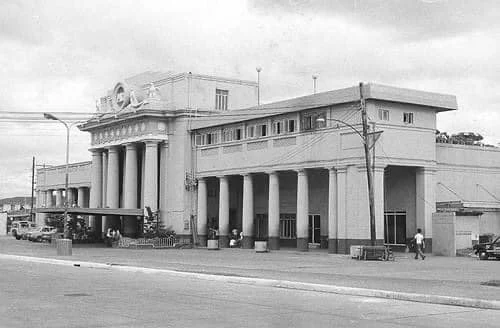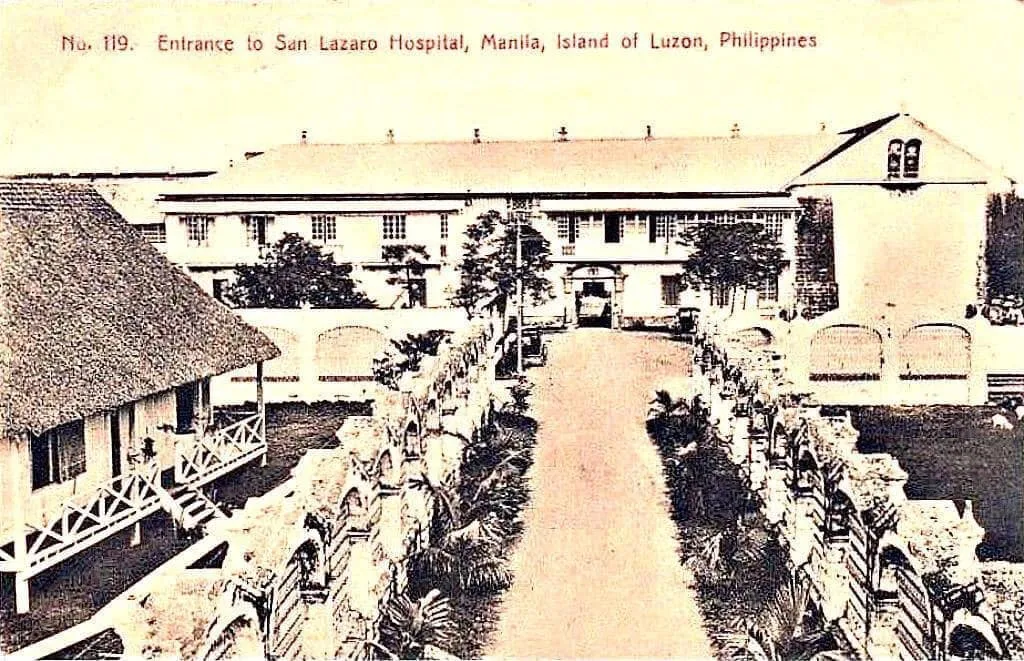History of Paco Manila Philippines | El Pueblo de San Fernando Provincia de Manila
 |
| 1910 postcard of Estero de Paco where the town center of San Fernando de Dilao is situated |
Dedicated to Saint Ferdinand, King of Castile and Leon (Feast: 30 May), the town of San Fernando, more commonly known as Paco, is a merger of the extramuros towns of Dilao and Santiago, and the Barrio of Peñafrancia. It was established in 1791, and is the successor of the 17th century japanese town of Dilao.
 |
| Snip of the Map of San Fernando de Dilao 1819 |
 |
| The oldest known sketch of the church of San Fernando built in 1809 Photo credits to Mr. Nicholas Torrontegui |
 |
| The old church of San Fernando after the Philippine Revolution. This ruins were demolished to give way to the present structure built in 1931. Photo credits to Mr. Nicholas Torrontegui |
 |
| The Church of San Fernando in 1945 |
When the extramuros towns were razed by a fire in 1783, it had been decided not to rebuild them again as they were proven a threat to the walled city following the British Invasion of 1762. The towns of Dilao and Santiago moved inland along Estero de Paco, near the Barrio of Peñafrancia in 1791. This union sparked a controversy among the residents as to what name shall be adopted for the new town, as each of the three entities wanted to preserve their original name. The colonial government intervened and decreed that the town be known as San Fernando.
 |
| Image of St. Ferdinand, King of Castile and León, patron of the town of San Fernando since it was established in 1791. Photo credits to San Fernando de Dilao page |
The Franciscans who were then administering the old town of Dilao, was given the administration of the new town of San Fernando. It then became a common practice to affix the name Dilao to the name of the new town of San Fernando, thus it was commonly known as San Fernando de Dilao. The first town church made of light materials was built in 1791. A stone church was then built in 1809. The Señor Santo Sepulcro, a popular devotion among the Franciscans, was then installed in the church in the early 19th century. The popularity of the Friday devotion to the Señor of Paco (traditional feast day: 19 August) among the masses was comparable to that of the Señor Nazareno of Quiapo during the 19th century.
 |
| Archival photo of the main entrance of Paco Cemetery |
 |
| Mortuary chapel of Paco Cemetery, now known as St. Pancratius Chapel Photo credits to Lorenzo Bukas |
The Municipal Cemetery of Manila was built at the outskirts of San Fernando in 1820. The tower of the town church was constructed in 1841 but collapsed during the earthquake of 1852.
 |
| Colegio de la Inmaculada Concepción de la Concordia established in 1868 Photo credits to La Concordia College page - Paco Manila |
In 1868, Doña Margarita Roxas de Ayala converted her villa by the Pasig River in Paco into the Colegio de la Inmaculada Concepción de la Concordia and donated it to the Daughters of Charity.
 |
| La Tabacalera in Calle Marquis de Comillas, built in 1881. The site is now occupied by Puregold Headquarters - Paco Manila |
The Compañia General de Tabacos de Filipinas, commonly known as the Tabacalera, built their factory and headquarters in Paco in 1881. The Daughters of Charity also established Asilo de San Vicente de Paul, popularly known as Convento de Looban, in Paco in 1885. The church of Paco burned during the Philippine revolution in 1899.
 |
Photo credits to ClaireMRA of Wikimedia commons
— in Paco, Manila. |
 |
| Facade of Paco Public Market facing Angel Linao Street. It is one of the few surviving pre-war markets in Manila — in Paco, Manila. |
 |
| Facade Paco Public Market facing Estero de Paco — in Paco, Manila. |
 |
| Paco Train Station — in Paco, Manila. |
When the city of Manila was chartered in 1901, San Fernando was absorbed, reducing its independent municipal status to a district. The neighborhood of Paco was an affluent neighborhood during the American era. The Manila Railroad Terminal heading south was built in Paco in 1912. There was also a handsome public market and fire station built in Paco during the early 20th century. De La Salle College first opened its doors in the Perez-Samanillo Mansion, Paco in 1911. Even President Jose P. Laurel had his Manila residence in Paco before the war. The church of San Fernando was reconstructed by the Belgian CICM priests in 1931.
 |
| Photo credits to coconuts.co — in Paco, Manila. |
 |
| The old Paco Fire Station |
 |
| The Residence of Pres. Jose P. Laurel in Paco Photo credits to Mr. Dennis Raymond Maturan |
 |
| The old mansion of the Perez-Samanillo Family where De La Salle College first opened its doors Photo credits to Ms. Isidra Reyes |
 |
| A pre-war building in Paco designed by Arch. Andres Luna de San Pedro |
 |
| Coca-Cola Factory in Paco built in 1948. It is now Landers Superstore Photo credits to Ms. Isidra Reyes |
Many pre-war residences in Paco were destroyed during WWII. However, there were also notable buildings like the Art Deco Pako Building (1939) and Bellevue Theater (1933) that survived. After the war, Paco started to be engulfed by industrialization. Several factories were built in Paco, most notable of which is the Coca-Cola Factory built in 1948. Today, many high rises are already sprouting in the environs of Paco, but its iconic heritage structures are still standing proud, giving one a glimpse of its bygone splendor.
El Pueblo Japones de Dilao
Extramuros de Manila
When the Spaniards came to Manila, Japanese were already trading with the natives. They usually came here during January to March when the Amihan (trade winds) had helped them sail south towards our islands. When Martin dr Goiti landed in 1570, he found 40 japanese permanently settling here. The colonial government deemed it important to establish trade relations with Japan because of arms & weaponry, and more importantly wheat. This grain was essential for the Spaniards to bake their customary bread.
 |
| Legend: | d. Barrio San Anton | e. Pueblo de Dilao | f. Hospital de San Lazaro | Credits to Mr. John Tewell |
And so in 1584, Spanish Manila formally established trade relations with Japan through the port of Hirado, Nagasaki. The first official trading ship from Japan anchored in Manila in 1585 paving the way for the influx of Japanese merchant settlers. However, because of the threats of the Hideyosi expansion, Governor General Gómez Pérez Dasmariñas confined the Japanese settlers in the estate of Balete (Nipal de Balete) when the walls of Intramuros was built in 1592. They were placed at the premises of the Franciscan convent of Dilao which had been established a decade earlier in 1581.
They grew in large numbers that by 1595, there were 1000 Japanese settlers in Manila. On 22 March 1601, the town of Dilao was formally established. Just like Parian, Dilao was considered a ghetto. The administration of the Japanese population was given to the Franciscans of the Convent of Nuestra Señora de la Candelaria de Dilao. Named after Turmeric or Luyang Dilaw, it was located east of the walls of Intramuros where Manila City Hall is currently situated. It was one of the original extramuros towns, and a bulwark of the walled city is named after it. From Baluarte de Dilao, cannons were pointed to its direction. Initially, the town of Dilao was only about 170 meters away from the walls of Manila.
The Japanese population of Dilao helped Spanish Manila quell the Chinese rebellion of 1603 which saw the massacre of 20,000 sangleyes. By 1605, the Japanese population grew to 3000 when the spanish population of Manila was only 2000. The Japanese settlers of Dilao also helped the Iberian reconquest of Moluccas from the Dutch in 1606. Christianity became persecuted at the beginning of the Tokugawa shogunate that in 1614, Christian Japanese started to be expelled from their homeland. The refugees settled in Dilao and San Miguel (San Miguel was the home of the exiled Christian samurais). The most prominent refugee was a Japanese Daimyo Takayama Ukon, now known as Blessed Justo Takayama.
The natives of the Venerable Orden Tercera (VOT) established themselves in Barrio San Anton in Dilao in 1619. Attached to their chapel was the Hospicio de San Pascual Bailon. In 1632, the Tokugawa Shogunate expelled Christian lepers which was received by the Hospital de los Naturales of Dilao. The hospital then came to be known as Hospital de San Lazaro.
Many Japanese settlers opted to return to their homeland during the persecution. The Japanese population of Manila downsized to 2000 by 1619. Immigration came to a full halt in 1639 when Japan went into isolation. Those who settled here had intermarried with the locals and assimilated. Trade relations of Spanish Manila and Japan officially ceased in 1640.
 |
| San Lazaro Hospital and Chapel moved to its present site in Hacienda de Mayhaligue in 1785 |
Dilao remained outside the walls of Intramuros for almost two centuries. The church of La Candelaria and San Lazaro Hospital were ordered to be demolished by Governor Manrique de Lara in 1662 and the stones were used for the defenses of Manila against the threat of invasion by Koxinga. When the town was rebuilt, it was moved further inland and was placed approximately 400 meters away from the walls.
The British used the extramuros churches to besiege Manila in 1762. The invaders mounted cannon attacks from their belfry, and so the towns of Parian, Dilao and Bagumbayan were ordered demolished. The church of VOT transferred to Sampaloc in 1785 while San Lazaro Hospital transferred to Hacienda de Mayhaligue that same year. The settlement of Dilao transferred inland along the banks of Estero de Paco in 1791 and was merged with the barrios of Santiago de Tattarin and Peña de Francia. A new church was built and the town was renamed San Fernando by royal decree. The namesake is King Ferdinand III of Castile, canonized as a saint in 1671. The proper name may have been too lengthy, so the name of the creek where it is situated stuck as its popular name which is Paco.
In 1901, the town of Paco was absorbed as part of the charted city of Manila. To this day, the district of Paco remains a bustling education and commercial hub.
____________________
References:
1. Estado, Geografico, Topografico, Estadistico, historico-religioso de la Santa Apostolica Provincia de San Gregorio Magno by Fr. Felix Huertas
2. historicalpaco.blogspot.com
3. BALETE. Arquitectura en la Comunidad Japonesa de Manila entre 1601 y 1762 by Pedro Luengo
4. La Colonia de Japoneses en Manila en el marco de las Relaciones de Filipinas y Japón en los siglos XVI y XVI by José Eugenio Borao
5. The World of the Manila-Acapulco Galleons by Angara & Madrid
6. The historical marker of the church of San Fernando de Dilao
(C) text by Lorenzo Bukas







No comments:
Got Something to Say? Thoughts? Additional Information?